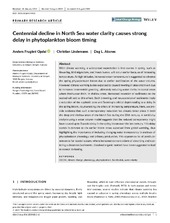| dc.description.abstract | With climate warming, a widespread expectation is that events in spring, such as flowering, bird migrations, and insect bursts, will occur earlier because of increasing temperature. At high latitudes, increased ocean temperature is suggested to advance the spring phytoplankton bloom due to earlier stabilization of the water column. However, climate warming is also expected to cause browning in lakes and rivers due to increases in terrestrial greening, ultimately reducing water clarity in coastal areas where freshwater drain. In shallow areas, decreased retention of sediments on the seabed will add to this effect. Both browning and resuspension of sediments imply a reduction of the euphotic zone and Sverdrup's critical depth leading to a delay in the spring bloom, counteracting the effect of increasing temperature. Here, we provide evidence that such a transparency reduction has already taken place in both the deep and shallow areas of the North Sea during the 20th century. A sensitivity analysis using a water column model suggests that the reduced transparency might have caused up to 3 weeks delay in the spring bloom over the last century. This delay stands in contrast to the earlier bloom onset expected from global warming, thus highlighting the importance of including changing water transparency in analyses of phytoplankton phenology and primary production. This appears to be of particular relevance for coastal waters, where increased concentrations of absorbing and scattering substances (sediments, dissolved organic matter) have been suggested to lead to coastal darkening. | en_US |

